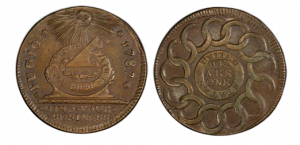The Fleeting History of the Fugio Cent
Posted on — 3 CommentsNo coin more perfectly represents the passage of time than the Fugio Cent. The coin, sometimes called the Franklin cent, is a work from Benjamin Franklin.
An inscription on the obverse reads “fugio” which is Latin for “I flee,” referring to the common adage that time flies. This is a fitting sentiment for a coin that was minted for only one year in 1787. The same side shows a bright sun with rays shining down on a sundial. Another inscription on the bottom reads “Mind your business” urging Americans to focus on their affairs in much the way Franklin did as a devoted entrepreneur.
The coin has the distinction of being the first circulation coin in the US. In 1787, the Congress of the Confederation of the United States authorized the creation of a copper penny that would eventually become the Fugio Cent. Franklin took inspiration from the 1776 Continental dollar that was minted in pattern pieces but never circulated.
The reverse has an image of linked rings meant to represent the unity of the original thirteen colonies with the motto ‘We are one” in the center.
The total quantity of Fugio Cents minted was relatively low at just 400,000. Ultimately, several thousand coins were stored in the basement of the Bank of New York in 1788. Almost 70 years later the same coins were packaged into cotton bags and stored for a second time. In 1926 the coins were rediscovered at which point they were distributed as souvenirs to customers and various officials. Several were sent to the American Numismatic Society. Today approximately 819 are in storage at the bank.
Research suggests that there are fifty-five varieties from twenty-four obverse dies and thirty-three reverse dies. The difference in these variations can be found in the style of sun rays on the obverse. Some versions have fine pointed rays while others have rays that are more club-shaped.
The historical significance of the Fugio Cent is more than its imagery or the fact that Franklin designed them. Consider that the copper used to mint the pieces was originally used in the bands used to hold together powder kegs provided by the French government to the United States during the American Revolution.
Today the coin remains a highly sought-after piece by collectors. In fact, some collectors seek out a rare variety called the “New Haven Restrike” which consists of both copper and silver. Some postulate that the Scovill Manufacturing Company struck these pieces in Waterbury, Connecticut. These versions are usually identified by the “G” in the word fugio. The original Fugio Cent uses a “C” with a straight line and a cross added to create the letter “G.” The New Haven Restrike, however, uses a cross stroke that only extends outward. Additionally, the linked rings are thinner on the New Haven Restrike.
The Fugio Cent is a must for anyone seeking a complete collection of coins that represent the formation of the US. The motto, creator, and even the source of the material all have origins in some of the most iconic aspects of our history.
Want to read more? Subscribe to the Blanchard Newsletter and get our tales from the vault, our favorite stories from around the world and the latest tangible assets news delivered to your inbox weekly.
3 thoughts on “The Fleeting History of the Fugio Cent”
Comments are closed.








What are the pennies for
How much is this coin worth if i have one
Hi Helen:
Because there are so many variables that go into determining the value of rare coins, we always suggest you go in person to a reputable coin dealer in your area. They’ll be able to see the coin and give you more information.